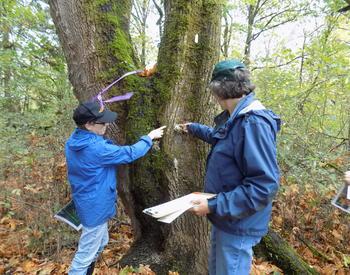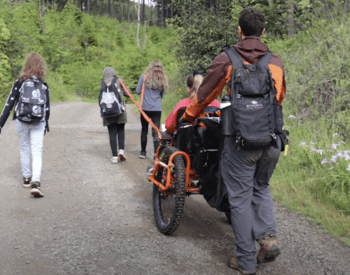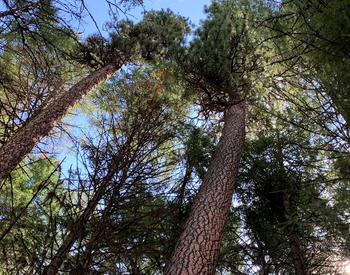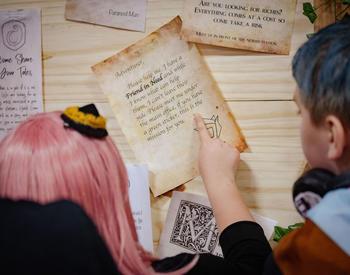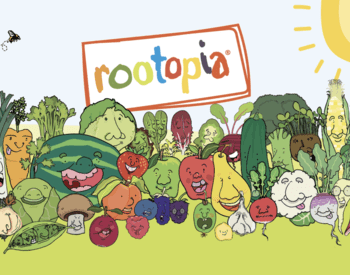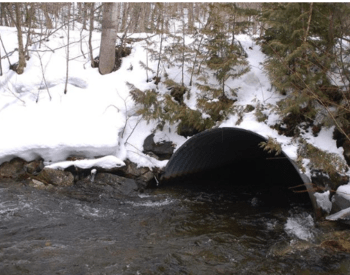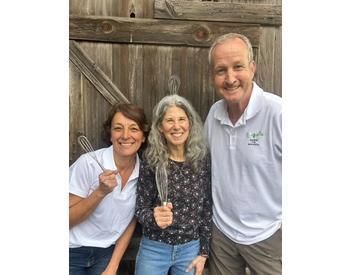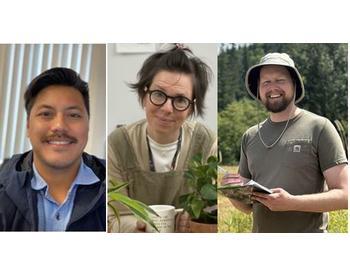GLIDE, Ore. – Under the roof of an outdoor classroom in the Glide Educational Forest, North Douglas Elementary School fifth graders learned about how wildfires start and how they are extinguished.
The students, attending the annual Douglas County School Forestry Tour organized by the Oregon State University Extension Service, crowded around a model of a ridge and a valley floor that was covered with wood shavings.
“You have your fuel. You have your heat, which can be from lightning, it could be a spark from someone dragging chains on a trailer, it could be from a campfire, and it will start a fire,” said Justin Grubbs, an advanced forest officer with the Douglas Forest Protective Association.
And then Grubbs did just that, using a lighter to ignite a small amount of flammable fluid he had sprayed on the shavings.
The children reacted to the flames with oohs and aahs.
“Our goal is to get rid of all that fuel,” Grubbs said, using a Hot Wheel-sized bulldozer to simulate a firebreak by clearing a path around fire.
“Basically, you trap it,’ he said. “And it will stop it.”
Minutes later, after correctly answering that water is needed to put the fire out, the North Douglas group walked from the fire management station to the fisheries station, where they learned about the species of fish that are found in Oregon.
This scene was repeated throughout the morning as hundreds of fifth grade students learned about a variety of forest-related topics.
“The education in the woods is very unique, as we have stations built into the forest,” said OSU Extension forester Alicia Christiansen, adding that she’s using grants and private donations to rebuild the stations – most of which are decades old.
“Phase 1 has begun and It’s going to be a long and expensive process, but it adds a fun element to this historical event,” she said.
Generations of Douglas County elementary school students have attended the annual event, which has been held at the Glide Educational Forest for 61 years. In the beginning it was known as “The Forestry Expo.”
The event requires six months of planning, Christiansen said.
'Deep roots' in Douglas County
More than 50 adult volunteers take part in the three-day event. This year two dozen public, private, Montessori and home-based schools signed up for the tour, with 830 students attending.
Tour instructors are recruited from federal, state and local resource management agencies as well as tribes, nonprofit organizations and private timber companies.
“This is the longest-running forestry and natural resources educational event in Douglas County,” said Christiansen, who has been with Extension for eight years. “The forestry industry has deep roots in Douglas County. Roseburg calls itself the Timber Capital of the Nation. We have mills, private companies, agencies and nonprofits that are all connected with maintaining and sustaining our forest resources.”
Each morning, groups of students rotate among seven learning stations on two circuits: the “Yellow Loop” and the “Green Loop.” Classes are assigned to a loop and rotate through the stations to learn about forest resource management topics from resource professionals. Station topics this year were:
- Forest management
- Fire management
- Fisheries
- Tree identification
- Archaeology
- Wildlife
- Forest products
After lunch, the students participate in traditional logging sports games. In the cross-cut saw activity, pairs of kids work on each side of the saw to cut through a log while an adult supervises and offers guidance and encouragement. They get to take home the piece they cut off – a “wood cookie.”
Another game that teaches students teamwork is choker racing, where a pair of kids set a miniature choker cable on a small log and in tandem drag it across a gravel lot to a finish line.
Planting seedlings
In 2022, Christiansen received a grant from the Society of American Foresters to partner on a design for a new activity that teaches students how to plant and care for native seedlings. After learning hands-on about the process, students take home Douglas-fir seedlings to plant with their families, as well as an instruction card with information about the state tree and Oregon’s forests.
“Many of our county’s students live on forestland,” Christiansen said. “The kids get to practice planting a tree and then they get to go home with a seedling that they can plant at their house or share with a friend and hopefully, share some of their new forestry knowledge along the way.”
